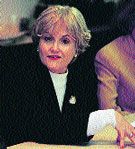Healthcare Public Relations: In The Driver's Seat?
Pharmaceutical Executive
From flacks and hacks to spin doctors and drug pushers, the cliches used to describe healthcare public relations professionals have fostered an image of PR that is, if not downright sleazy, at least suspect.
From flacks and hacks to spin doctors and drug pushers, the cliche used to describe healthcare public relations professionals have fostered an image of PR that is, if not downright sleazy, at least suspect. Despite its foundations in science and public welfare, healthcare PR has been tagged as "advertising's stepchild" and routinely takes a back seat whenever pharma company clients make budget decisions.

Seated (l to r): Pat Pesanello, PwC Consulting; Nancy Turett, Edelman Health Practices; Kathryn Metcalfe, Cohn & Wolfe Healthcare; Josh Weinstein, jwEinstein Strategic Messaging. Standing (l to r): Teri Cox, Cox Communications Partners; Ame Wadler, Burson-Marsteller; Kathy Bloomgarden, Ruder Finn; Hope Krakoff, eMaven; Max Gomez, WNBC-TV New York; Nancy Rueth, Noonan/Russo PResence Euro RSCG; Michael Durand, Porter Novelli; Wayne Koberstein, Pharmaceutical Executive; Heidi Yeranossian, Madison on Main Communications; Stephanie Marchesi, Manning, Selvage amp; Lee; Kym White, Ogilvy PR Worldwide; Marilyn Castaldi, Fleishman Hillard; Susan Noonan, Noonan/Russo PResence Euro RSCG. On stairs (left to right): Carolyn Glynn, Roche; Gianfranco Chicco, Chandler Chicco Agency; Richard Chamberlain, Chamberlain Communications Group; David Catlett, Ketchum; Kathy Cripps, Council of PR Firms; Laura Schoen, Weber Shandwick Worldwide; Ilyssa Levins, GCI Group.
But from the vantage point of those attending Pharmaceutical Executive's roundtable in New York, healthcare PR may not only have laid the strategic groundwork for many of today's most familiar pharma marketing tactics, it may also soon be recognized as the key driver of pharma marketing.
Last December, PE brought together more than two dozen PR healthcare leaders, setting the stage for select agency executives to tackle the issues that have kept PR in the shadows of its more extroverted marketing cousins-DTC advertising and professional promotions. All participants have one thing in common: They agree that their time behind the scenes is over and that it is up to them to raise awareness of public relations' value to pharma-its impact on sales, corporate image, and the industry's reputation.
When Wayne Koberstein, PE's editor-in-chief and roundtable moderator, introduces the day's theme-"Should public relations be the driver, navigator, or passenger of pharma marketing?"-Nancy Turett, president and global director of Edelman Health, asks, "Are those our only choices?"
Unlike their colleagues in advertising, PR professionals generally do not separate account management from creative work. Effective agency staffers must serve as strategic consultants, tactical engineers, scientific writers, account managers, graphic designers, consensus builders, patient recruiters, media informants, and public health advocates. In fact, PR agencies operate at every level of their pharma clients' business, primarily because they broker relationships between companies and a long list of important audiences: healthcare providers, managed care organizations, insurers, government agencies, regulators, patient and consumer groups, and the media.

Wayne Koberstein
The Future of Pharma
As the pharma industry accelerates its integration of R&D and marketing functions, many employees find themselves forced to acquire the skills for both areas. According to the roundtable's keynote speaker, Patricia Pesanello, PwC Consulting's director of global pharmaceutical practice, PR professionals have multitasked all along and will continue to drive integration of those and other functions. Despite that prediction, she says companies still have a hard time grasping PR's value: "Public relations is starting to track and pinpoint what its contributions are, and they correlate with an indicator of success-usually some form of market share or sales." Pesanello cites research showing healthcare public relations' traditional functions and specialty areas that support pharma's overall marketing and sales goals. Those include:
- informing audiences of, and managing expectations for, new products coming to market
- providing educational materials that teach physicians and patients to use new products safely and effectively
- supporting marketing and sales' special events and promotional activities
- handling communications among companies and government and financial audiences
- managing employee relations within companies
- anticipating and preparing crisis communications plans.
According to Pesanello, overall increases in pharma marketing expenditures have fueled the growth of new forms of consumer outreach, with advertising and traditional marketing companies "crossing into the domain of public relations." As investments in DTC advertising and sales forces increased, the distinction blurred between the roles of consumer outreach-traditionally an advertising function-and public education, a goal of PR.

Forces Shaping Pharma's Future
"Those roles are complementary," she says. "In the last few years, as the industry has learned how to manage direct-to-consumer advertising and promotions, it has not only become more skilled, but it has also recognized the role of public relations."
Pesanello cites PwC research, conducted during the DTC ad explosion of the mid-1990s, examining pharma companies' organization and management of DTC activities. PwC found two models: a decentralized one in which product teams specialized in direct-to-consumer marketing and a centralized one in which companies relied on a "center of expertise" in consumer outreach.

Patricia Pesanello; PWC Consulting
She says, "In at least one company, when it was time to do DTC, they turned to their in-house public relations, asking, 'How do we reach out to the public and the patient-the consumer? You, within the company, have the greatest expertise for reaching that segment.' And what evolved was a centralized model." (See "Forces Shaping Pharma's Future.")
Although the decentralized model still dominates, Pesanello claims that pharma companies have begun to recognize the value of a center of excellence and that some of the skills involved in consumer outreach "require coordination or centralization across product teams. In 1998??1999, it really didn't matter what mode was used. What mattered was how well you could operate, how well you could bring perspectives together to build and execute the plans."
But the proliferation of e-business brought interactivity and thus a better understanding of the many audiences relevant to pharma. That made relationship marketing-two-way communications with those audiences and various market segments-more important. Pesanello cites the Hispanic community as a good example of a market segment that benefited from tactics that were more closely related to PR than traditional product marketing. She attributes that to the globalization of DTC advertising and product promotion.
Pesanello also notes that companies' sharpened focus on measurability and ROI is affecting the entire marketing mix, including DTC advertising, professional sales forces, and public relations-although PR's biggest problem has been to
quantitatively measure and prove its value. Consequently, PR agencies are exploring new metrics to replace the old standards-audience impressions and clip books. (See "Client's View," page 58.)
She concludes that PR professionals already use the skills required to be successful, especially those who:
- excel in conducting and coordinating launches
- manage the complexity of delivering messages to multiple audiences
- create "customer" interaction value through relationship marketing
- achieve operational excellence by
- integrating processes and deploying enabling technologies
- build public responsiveness and leadership.
It's About Trust
Public relations' traditional function has been to create positive images of individual companies and their products-and protect their reputations. Now, says the moderator, because of public scrutiny and suspicion related to product pricing and perceived corporate greed, it must position the entire industry and its value to society. For many veteran professionals at the table, the roar of public debate has hampered their and their clients' abilities to communicate positive news or images. (See "The Holmes Report.")

The Holmes Report
"Isn't the onus as much on the industry as it is on us as communicators to manage those perceptions?" queries Turett. "People ask, 'How dare you profit from my illness?' They resent the industry partly because it's associated with the most difficult times in their lives. It's about life and death, and the onus is on us to explain the industry's value. So why is public relations a dirty word? Maybe because our outreach programs to explain pharma companies' value aren't extensive or consumer-directed enough."
Turett asserts that PR agencies have long directed their communications to consumers but that they haven't had a big enough share of pharma's budget to be effective. Some of pharma's attempts to address pricing and other heavily debated issues failed, not because they were poorly done but because they were poorly received, says Kathryn Metcalfe, executive vice-president and managing director for Cohn & Wolfe Healthcare. She says, "Both programs-the GlaxoSmithKline and Novartis discount cards-were described pretty widely in the media as public relations ploys. So the public didn't even accept them for what they really were, and they're central to the value of the industry."

Nancy Turett
Marilyn Castaldi, senior partner, senior vice-president, and healthcare practice director for Fleishman-Hillard, adds, "There are many dichotomous messages out there. On the one hand, there are drug discount cards and the
effort to give medicines away. At the same time, there's the patent issue and pharma's efforts to affect whether generics of their leading brands come to market. Pharma companies are giving discounts because they know that Medicare will eventually get a pharmaceutical benefit. It probably would have already if September 11th hadn't happened."

Marilyn Castald
Kathy Bloomgarden, president and CEO of Ruder-Finn, offers a different perspective on the issue of public trust. "I don't think pricing is a public policy issue," she says. "I think it's fundamental to the industry's reputation. That's why Business Week covered pricing. It's unprecedented, the amount of attention it's gotten. And the debates, whether over Bayer or Cipro, are all centered heavily around pricing. The recent GSK and Novartis discount cards are real actions that will give something back. Pharma recognizes that it, together with the government, will have to take concrete steps on the access-to-medicines issue. In many instances innovative high-priced medicines are accepted because they generate some cost-savings. But fundamental trust must be established, and that is deeply intertwined with the issue of pricing, which is at the heart of the industry's reputation."

Kathy Bloomgarden
Runaway Publicity
Except for Enron, no other company in recent times has had its reputation on the line as much, and as publicly, as Bayer.
In fact, before September 11, the word "Cipro" (ciprofloxacin) was used mainly in private discussions about urinary tract infections. After September 11th, it was a household word in the United States and elsewhere around the world. The question of its availability thrust Bayer into the fast lane of controversy while the rest of the industry-including makers of other antibiotics used to treat anthrax-idled in neutral. Today, the news media, government officials, patient advocates, physician groups, pharma companies, and their consultants are still debating why that happened.

Nancy Rueth
At PE's roundtable, however, fingers point to a failure by all parties to handle the situation properly. Roundtable participants say they all should have shifted into high gear to communicate the availability of antibiotics such as Vibramycin and penicillin to quell the anxieties of a panicky nation.
Roche spokesperson, Carolyn Glynn, vice-president of public affairs, uses the Cipro case to illustrate PR professionals' responsibility to anticipate and prepare for the reactions of multiple audiences-including the media, patients, physicians, and government-to breaking news and conflicts. As to how well that particular case was handled, the jury's still out.
Max Gomez, PhD, a medical correspondent and health and science editor for NBC's New York affiliate, says, "For Bayer, Cipro was probably a public relations disaster. I disagree, by the way, that it was a good idea to break the drug's patent simply because people wanted to use it as an anti-anxiety medication. If there were a real need for it, the argument would be different. But the argument here is that the perceived need for a medication was so great that the government wanted to, or was seriously proposing to, violate a patent. Bayer and its public relations people should have anticipa- ted the situation."
Though they reach no consensus on the best way to handle messages about the availability of public health treatment, participants agree that in the Cipro case, the public's negative attitudes toward the industry added to the anxiety that pharma companies would leave them defenseless against a bioterrorist
attack. David Catlett, global healthcare director for Ketchum, says, "There's a public perception that pharma companies should behave like government institutions and public trusts, which they're not. The question is ultimately, 'At what point do people recognize pharma companies for what they are-businesses with a certain responsibility but also businesses like any others? As in all other industries, there's a sales function and a marketing function, but you have to be careful how you communicate that."

David Catlett
Referring to the Cipro case, Catlett adds, "While people were saying, 'Where was Bayer?' the question is, 'Why wasn't the government saying there are other antibiotics options?' That didn't come out until well after Bayer was taking heat. The government fumbled on both the federal and local levels. They gave out the wrong information. The whole Cipro patent issue would not have been as big a deal if people realized there were other sources of treatment for the threat."
"The pharmaceutical industry has a black eye, yet we're spending so much more than the government spends on R&D," says Heidi Yeranossian, president and founder of Madison on Main Communications. "New drugs wouldn't be available otherwise."
"We get very frustrated when there's an image problem," says Gianfranco Chicco, co-founder of the Chandler Chicco Agency, which counts Bayer as a key client. "The first thing Bayer did with Cipro was to advertise it. A lot of companies' first move is to put the word out through paid media. And as we know, that is not the most credible way of fixing a reputation."

Gianfranco Chicco
Chicco may be right, and so may the others who voiced their opinions. But data from omnibus telephone surveys conducted by Roper and Opinion Research Corporation for Bayer in October and November of 2001 showed that the company's reputation was intact. In fact, 81 percent of 1,000 Americans surveyed agreed that Bayer did a good deed by selling Cipro at a 50 percent discount to the US government. More than half (58 percent) agreed that Bayer was doing enough to support the United States in the fight against bioterrorism.
Other results showed the public's appreciation for the situation's complexity. Fifty-nine percent thought the government acted correctly by honoring Bayer's patent for Cipro; 35 percent believed the government was right in threatening to break it. (See "Bayer Responds," chart)
Healthcare Public Relations continues with link to page 4
Page 3 is related issue, "Clients View"
Client's View: Roche Spokesperson Carolyn Glynn, VP, Public Affairs
Public relations is increasingly becoming part of the pharma industry's marketing mix, joining the more established disciplines of medical education, professional and consumer advertising, and direct mail. But, despite PR's advances, it continues to suffer from a perception that it fails to drive business or product success. In fact, when done right, PR can be a major strategic partner with marketing in enhancing brand identity, driving consumer demand, and facilitating appropriate product use.
Although the field is expanding and demonstrating that it can deliver value to brands, it will remain vulnerable to budget fluctuations because of the lack of industry-wide standards for evaluating PR's impact on sales. The profession needs to grapple with that fundamental issue: how to consistently measure the impact and value of public relations across all its facets. The days of assessing PR results through media impressions are long gone. Now, we need to demonstrate the value of earned media for driving consumer interest in our products, leveraging third-party and advocacy support, and expanding the impact of professional communications on appropriate product use.
We must find common terms for communicating to marketers where and how PR affects the prescription algorithm. Measurement is not just taking impressions one step further. It's the ability to discuss what we do and demonstrate it through a common language. What is PR's impact? How does it influence consumers? How does it influence professional perceptions of the company and its products? How does it influence third-party advocates and neutralize critics?
We talk about all the great things PR can do for corporate reputation and image, but in the traditional environment for marketing pharma products, that skill isn't always visible in how it influences a company's brands. We've all heard brand managers say, 'I don't want people to know what the company name is. I just want to market my brand.' But reputation-pertaining to specific products or to a company-will eventually affect decisions by professional customers and patients about the use of your products.
It took the industry a long time to realize that many external constituents touch the lifecycle of a prescription medication. For decades, our focus was on communications with doctors and other healthcare professionals. More recently, the healthcare system has evolved to include key influencers such as managed care, hospital systems, government and regulatory officials, consumers, and ultimately, patients. It took the industry a while to understand that some of those groups may not appreciate or fully understand the extensive research, development, and marketing processes that are necessary to deliver quality medicines. As a result, the industry was faced with the urgent need to explain itself and relate to those new customers in unfamiliar ways.
As simple as it may sound, we arrived at the point where we said, 'There are all these other parts of our society that we must communicate with. We have to start telling people what we do and demonstrate the cost-effective value that our products provide.'
The PhRMA advertising campaign, which is only one part of a broader industry initiative, was established to help give the industry a more personal and familiar face that our constituents could relate to and support. That's why the ads over the past few years feature real company researchers and real patients.
Everyone knows the value of prescription medicines for improving health and saving lives, but few understand the rigorous process, time, and expense that the industry invests to deliver those products to the marketplace. PhRMA's ads are one way to communicate that important information.
Michael Durand, director of Porter Novelli's global health practice, adds that the Cipro issue was another example of the general disconnect between pharma and the millions of uninsured patients who lack access to many of the innovations that the industry has brought to the marketplace. "When Clinton was elected," Durant says, "there were 37 million uninsured and he vowed to do something about it. In eight years of Democrats and a year and a half of Republicans, we've gone in the wrong direction.

Michael Durand
"Are the pharmaceutical and public relations industries doing anything to help move that issue along in a positive direction? I think that, at some point, we're heading for a giant train wreck, and I don't think, without more productivity on industry's part, that we'll avoid it."
Kathy Cripps, executive managing director and co-director of Hill & Knowlton's US healthcare practice, agrees with Durand about the importance of pharma companies' responsibility to its custo-mers and suggests that some companies are leading the pack. (Cripps left her position at Hill & Knowlton and now serves as president of the Council of PR Firms.)
"J&J is a very good example," she says. "They're good corporate citizens. But I think that's where we can have a role as well, to continuously point out how the industry's individual companies can make an impact by having good corporate communication programs."

One roundtable participant criticizes the industry for its inconsistency. "The industry hasn't done a good job of being a leader," says Ame Wadler, healthcare practice chair for Burson-Marsteller. "It has a tendency to alternately defend itself and apologize. That goes back to its involvement with human life. The issues that the industry takes on are so much larger than what Pepsi has to deal with. But there is a need for a sustained commitment to telling a story and not retreating. The industry needs to stand up in the face of challenges that are unlike those in any other industry, not to retreat and band together behind their trade organization. It needs to take a consistent leadership role; to stop apologizing, then getting defensive about specific issues. Until that happens, nobody will understand what this industry does."
PR for PR
Just as pharma companies have not done enough to explain to the public what they do and the value they bring to society, healthcare PR agencies haven't promoted themselves to their pharma clients or to other audiences they serve-media, healthcare providers, and patients. The profession, for better or worse, has eschewed self-promotion and failed to get trade associations such as the Public Relations Society of America or the Council of PR Firms to do it on their behalf.
Healthcare Public Relationscontinues with link to Page 6
Page 5 is related article, "Media Lens"
Media Lens
With innovative new therapeutic agents moving from the lab to the bedside, the pharmaceutical industry is enjoying the best of times. There was a lot of encouraging news in the fight against cancer this year, partly because newly developed therapeutics didn't fall into the traditional triad of radiation, chemotherapy, and surgery. Gleevec made big news, because it was a proof-of-concept drug-one that illustrated an effective new way of attacking the disease.
It's also the worst of times, because pharma companies have an image problem.Many medicines that patients must take for the rest of their lives are very expensive. That's good for pharma companies financially, but it's a serious image problem for them when patients can't afford or access medicines through a company insurance plan.
Through education of the public and the consumer media, public relations professionals can help pharma's image problem. But local general assignment and medical reporters covering pharmaceuticals are not always that sophisticated about costs and other issues involved, so that makes public relations' job all the more difficult.
Because of that, PR people need to build anticipatory relationships with print and television reporters. They need to know who they are, who they need to talk to, and to cultivate relationships with them ahead of time. It's awfully tough during a crisis to build trust with reporters, and that's when those relationships are most valuable.
PR pros can also dramatically increase their success in placing stories by having a video in hand, especially one that puts a human face on the disease. If the story is about a drug for rheumatoid arthritis, the gnarled fingers and the ulnar deviation tell the tale. Otherwise, it's just a lecture to medical students.
Many therapies, especially those with interesting new mechanisms of action, scream for animation. A company may be able to explain how they work in two minutes, but if they show pictures, that tells the story better than 15 or 20 minutes' worth of explanation.
It serves everyone in the long term to have a better educated population that understands how drugs work, why they work, and why people are excited about them. Otherwise, the patient will say, 'I get a piece of paper from my doctor, I go to the pharmacist, and it costs me $1,000 to get this drug!'"
Article by: Max Gomez, PhD, health and science editor and medical correspondent for WNBC in New York, shares the media's view of public relations.
"One reason why marketing people get advertising," says Laura Schoen, president of global healthcare for Weber Shandwick Worldwide, "is because advertising has been much more effective in influencing business schools and trade groups, making sure that people understand their function. PR societies have failed us, but we haven't done our homework, either. Pharma company employees don't understand where we afunction in the marketing mix."

Laura Schoen
Consequently, agencies and their leaders must constantly justify their work and defend the value of their profession. Nevertheless, says Kathryn Metcalfe, its value has been there all along:
"We not only need to do a better public relations job for ourselves, but we also need to do a better job of educating customers. We have to consider the changing demands on today's product managers. They must be part of an integrated team. They're using lots of different tools and being bombarded with ideas and concepts. They are cycling in and out of marketing teams faster than anything. We in PR have longer tenure than two-thirds of the product managers we work with."

Vanity Searches
Teri Cox, managing partner of Cox Communications Partners, suggests that listing PR's many functions would help companies understand what the profession brings to their business. "For many years," she says, "PR was publicity, and that's all it was seen as. Now it's advocacy, crisis management-so many different things. We're marketing corporate image and products. There are generalists, but we're also segmenting and specializing more as a profession."
As clients' needs for cross-company and cross-department integration mount, PR agencies' must tap internal resources to meet the demand. That means agencies have the opportunity to show off what they know in their colleagues' specialty areas, such as investor relations (IR), medical education, consumer marketing, and crisis management. Many of the agencies represented at the roundtable offer services in those and other areas, including formal clinical trial patient recruitment, which helps them compete with CROs.

Bayer Responds
"We can demonstrate that, when you insert PR at point A in a clinical trial, you actually increase patient enrollment at point B," says Ilyssa Levins, chairman and worldwide director for GCI Group. "PR needs to sit at the table with clients at the time of clinical trial recruitment to help accelerate the drug development process."
"One of marketing's most critical tools is the clinical trial package," adds Wadler. "More companies are receptive to the idea of not just designing the trial for approval but also designing it in a way that will help with marketing. That's where PR can be very helpful, not only in terms of what trials will be important in answering the questions raised, but also in terms of how to shape those trials so they're most effective at postlaunch, when you need them."

Ilyssa Levins
"There are two kinds of drug companies-those that do science for science's sake and those that do science for marketing's sake," says Kym White, managing director of healthcare for Ogilvy Public Relations Worldwide. "But when there is an overlap and you have the data to work with after launch to keep the market alive, that's smart."
But PR's value to integrating marketing into early stage pharma R&D isn't a given. Pesanello says, "There's a growing recognition that what clients value in performance is more complex than increased scrips. We're seeing a movement toward measuring value, whether it is translated to stock price, plus market share, plus reputation, plus ability to launch well. Measurement of what PR contributes is being defined."

Kym White
The group also acknowledges the growing importance of investor relations and its rapid convergence with traditional PR. An example of that is the recent merger of Noonan/Russo, an IR agency, and PResence Euro RSCG, a PR agency. The new company, Noonan/Russo PResence Euro RSCG (NRP), reflects the integration of two fields that until recently, viewed themselves as serving separate audiences.
"In smaller companies-biotechs and those specializing in emerging technology-you see greater integration and rejection of the corporate myth that PR and IR are separate because the marketing and the corporate messages are totally blended," says Susan Noonan, NRP's president. "All the other constituencies are important, but if clients don't have investors behind them, it will be awfully hard for them to get money for joint ventures or anything else. Investor relations helps bring our credibility into the corporate suite."

Susan Noonan
Nancy Rueth, executive vice-president and general manager for NRP, brings the conversation full circle. She says, "Classically, what public relations has done is hit pressure points throughout the marketing mix from very early to when a product goes generic. During prelaunch, we do science communications on the one hand and disease or treatment education on the other-speaking to professionals, thought leaders, and consumers. People always think about the launch, but it's almost a given what you do then. What's important is a total pattern of activity in which timing and judgment make the difference."
Kathy Bloomgarden, who some say is the driving force behind Novartis' communications, brings up PR's facile use of the internet and other media tools in reaching audiences influential in research, regulatory, and marketing processes. Few pharma brands or companies exemplify the internet's power to influence those processes better than Gleevec (imatinib), Novartis' oncology breakthrough.
Bloomgarden says, "For brands with a short time to establish themselves, we can really deliver-get strong launches going, help with regulatory problems, and gain acceptance and support from patient groups. Public relations gives a great deal of support to the brand. That illustrates our business function."
"The internet enables us to gather data that we, in the PR community, have never been able to before," says Hope Krakoff, director of digital strategy consulting company eMaven. "And to target areas and see a reach and frequency that you couldn't see in the marketplace-such as the number of people going to an unbranded site for a generally unrecognized disease-and release that to the media is exceptional."
Josh Weinstein, president of jwEinstein Strategic Messaging, broaches the subject of meetings, recommending that PR pros remind clients that they offer services that may deliver more relevant results than their advertising or CME counterparts. He suggests, "It may be that we must disassemble some of what we intuitively put under the PR umbrella. We do excellent meetings with more punch because they involve not only thought leaders but also the media. Our use of events and our ability to do creative public education are not usually associated with PR because the industry tends to see us as focusing solely on media relations.
"Product managers-who, unfortunately, tend to be greener than they used to be-see those activities as sales promotions and not part of what we do. If we just call ourselves the PR group and don't start breaking that up for them, we might be missing the boat. We can show that we don't just do things as a series of one-offs. We form connections among the many audiences we touch through our varied activities to generate repeat hits for clients, so the value of our work increases geometrically as the word of mouth that we spread improves."
Gauging Impact
One of PR's top challenges has been to prove its relative value in boosting sales, compared with advertising and detailing, which are easier to measure. But maybe, the roundtable participants suggest, sales aren't the only thing companies should be concerned about. Maybe long-term goals should supercede the short-term obsession with sales.
Nancy Turett leads that argument by asking the rest of the group to acknowledge that, even though their companies may have efforts underway to develop standardized measurement tools, PR's value is somewhat defined by its intangibility.
"I'm concerned that we might back ourselves into a corner, saying we'll use a more sophisticated version of impressions and message analysis. Those are important things, and we should expect to have our feet held to the fire on those. But what we do is so much more. PR is about creating a web of interaction; it's about multiple stakeholders and information pinging from one to the other. If we go in the measurement direction, we need to build in some way of recognizing that, in some cases, the easier it is to measure something, the less credible and valuable it may be. I won't say that we're just like advertising, because we're not."
One thing that PR and advertising have in common is a perpetual quest for the ultimate pharmaceutical brand. That quest transcends the limits of agency identities and individual talents. Regardless of agencies' different strategic roles and responsibilities in clients' marketing plans, brand success is the constant that brings everyone together. That, the participants agree, should be the ultimate goal, no matter what type of agency is concerned. That means that sales aren't necessarily the top priority and that a more holistic measurement process would better capture PR's impact, not only on delivering messages but on developing them and getting them to the right audiences with the right vehicles.
Confirming the broader scope of today's pharma marketing, Koberstein describes companies' focus as "shifting away from just selling the product to making sure the product gets properly used. So issues of compliance and patient behavior become more important in that context. Pfizer just put $32 million on the line for disease management in Florida. That has nothing to do with marketing its products-they're essentially trying to convince people to live healthier."
Koberstein also touches on patient education, in which PR has been involved for decades, as part of a broader approach to managing a brand and its key audiences throughout the product's lifecycle. That approach, many experts say, brings to bear a company's best strategies and tactics in clinical trial protocol development, patient recruitment, publication planning, regulatory navigation, and professional and consumer education and outreach.
"We have to think of branding as more than just awareness," says Stephanie Marchesi, co-director of Manning, Selvage and Lee's US healthcare practice. "Look at the primary pillars of branding-relevance, esteem, and differentiation. PR is the discipline with the greatest opportunity to make the case for a product's relevance to a person's life or to elevate a brand's esteem in the public mind. Maybe, if you're lucky, when you launch a product, branding's about differentiation. More often, it's about finding a way to give that brand some meaning and value in the user's life. That's not limited to advertising by any stretch."
Levins echoes Weinstein's argument about dismantling the "PR umbrella" in her comments about the practice's role in reaching traditional marketing's key professional audience, healthcare providers. "Next to detailing, opinion leader development is the second most important factor in a successful drug launch," she says. "And we can do so much more. Companies spend $200 million on medical education and opinion leader development, and PR gets practically no funding, except some for advocacy relations and medical outreach."
Richard Chamberlain, president of Chamberlain Communications Group, addresses the patient audience when he says, "What we really bring to the party is an intimate understanding of what consumers feel. Some people have asked, 'Why is anthrax such a big deal? How come that's so inflammatory? Not that many people died.' That's true, but people are scared, and we need to be sensitive to that.

Richard Chamberlain
"Our job as PR professionals is to bridge the gap between what's real and what's irrational. And the media's not always rational. There are issues they grab onto and play out, but our job is to bridge the gap and help companies understand that their reputation is everything; that's what they're about. That level of trust that we've all touched on-how will we build that if we don't reach consumers where they are, rather than where they should be? In other words, if consumers don't get what we're saying, then we're not doing it right."
Koberstein challenges the panel to look at public relations as a two-way street. "For many years, industry has said, 'We have a great story. If we could just tell it to the public.' But to tell your story-and someone's perception of you is not usually enough-you have to listen to them and establish a dialogue."
Taking the Wheel
At the end of the day, Koberstein offers some conclusions and insights: "When PE first started to explore DTC-which people thought was quite ahead of the curve back in '92 or '93-I interviewed the head of a CRO who said, 'DTC begins in clinical research, the first time someone has to sign a patient consent form. At that point, we start integrating their expectations and what they understand against our scientific goals. And we have to teach them how to use the product, or we won't get good results.'
"He said if the company started learning about patients, it would make a lot of other things clear, down the line, in product development and marketing. I assume that's also true here, so PR has a tremendous potential, starting at the research level."
Summarizing the day's discussion about establishing trust, Koberstein notes that, although the pharma industry needs to engage the public in a two-way dialogue, it is unlikely that the public would understand, or care about, the finer points of patent law or regulatory submissions. He says, "Companies can have a dialogue with people and say honestly, 'We believe we're special, just like you do. We believe we have special obligations to you. But we are a business, and we have to also satisfy that part.' But they can't say that until a relationship is established, or it sounds merely self-serving."
Koberstein agrees with participants that healthcare public relations is poised to get behind the wheel "quickly and on demand." He compares agencies' opportunity for visibility to pharma companies' sudden "outing" in the public arena: "You've been in a secondary role for a long time, but that's changing, and I have a feeling it won't change gradually. It's going to flip anytime now, and you will be driving a lot of the corporate brand mix." z

Beyond the Prescription: Pharma's Role in Digital Health Conversations
April 1st 2025Join us for an insightful conversation with Jennifer Harakal, Head of Regulatory Affairs at Canopy Life Sciences, as we unpack the evolving intersection of social media and healthcare decisions. Discover how pharmaceutical companies can navigate regulatory challenges while meaningfully engaging with consumers in digital spaces. Jennifer shares expert strategies for responsible marketing, working with influencers, and creating educational content that bridges the gap between patients and healthcare providers. A must-listen for pharma marketers looking to build trust and compliance in today's social media landscape.